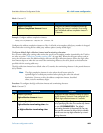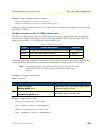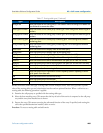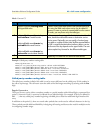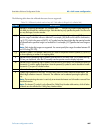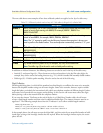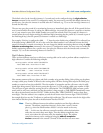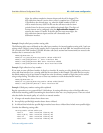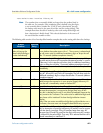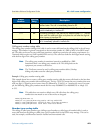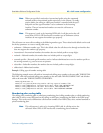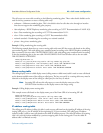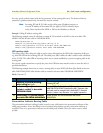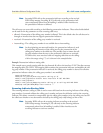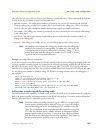
Call router configuration task list 470
SmartWare Software Configuration Guide 40 • Call router configuration
digits, the address completion timeout elapses and the call is dropped. The
digit collection timeout is active when a route is complete but a T-indicator
is specified on the selected route, e.g. when the dialed number of 0991 is
tried to match the entry 099T. In this case the call router waits for some
period of time for the user to enter additional optional digits. The digit col-
lection timeout can be configured using the
digit-collection timeout com-
mand in the context CS mode. If the user does not enter more digits, the
digit collection timeout elapses and the call is forwarded to the
destination interface.
Example: Simple called party number routing table
The following table routes call based on the called party number. An internal number starting with 5 and con-
taining at least 3 digits is routed to the interface that is connected to the local PBX. An international call to the
US is routed to the VoIP interface USVOIP. All other calls (local, national and international) are routed to the
interface that is connected to the PSTN.
node(cfg)#context cs
node(ctx-cs)[switch]#routing-table called-e164 DIST
node(rt-tab)[DIST]#route 5.. dest-interface PBX
node(rt-tab)[DIST]#route 001T dest-interface USVOIP
node(rt-tab)[DIST]#route default dest-interface PSTN
Example: Digit collection of any number
If you want to route calls from interface A directly to interface B, wanting to collect dialed digits, you have to
route calls from interface A to a routing table like the one shown in this example. This table does not require
the dialed number to be of any format or length but waits for arbitrary number of digits that can be entered
using overlap dialing. This allows the user to enter any number to reach the destination interface.
node(cfg)#context cs
node(ctx-cs)[switch]#routing-table called-e164 COLLECT
node(rt-tab)[COLLECT]#route T dest-interface OUT
Example: Called party number routing table explained
Regular expressions are very powerful for E.164 lookups. A routing table always tries to find the table entry
with the best matching prefix. Determining the best match is often not a very simple process. There are several
rules that define the match quality of a rule for an entered number:
1. A longer rule matches better than a shorter one.
2. An explicitly specified digit matches better than a wildcard.
3. A wildcard that include less possible digits matches better that a wildcard that include more possible digits.
Consider the following routing table:
routing-table called-e164 test
route 1 dest-interface IF1entry #1
route 1[0-4] dest-interface IF2entry #2
route 11 dest-interface IF3entry #3
route 111T dest-interface IF4entry #4



